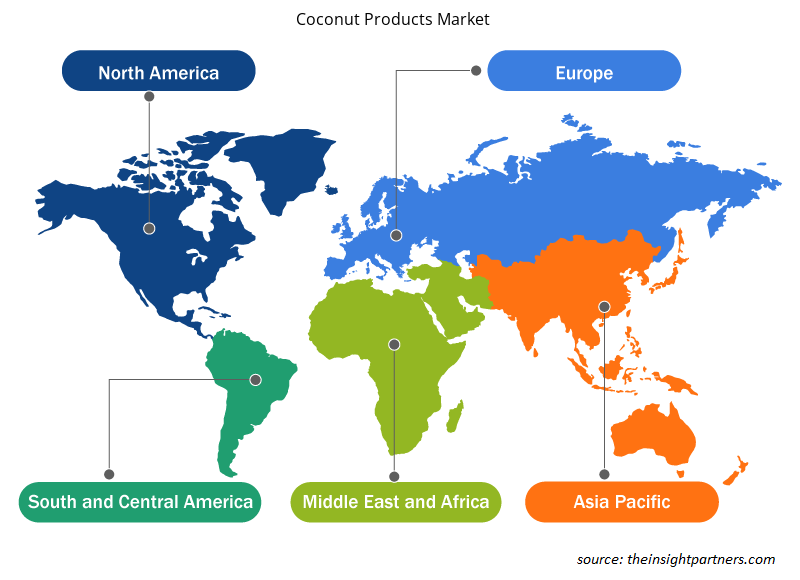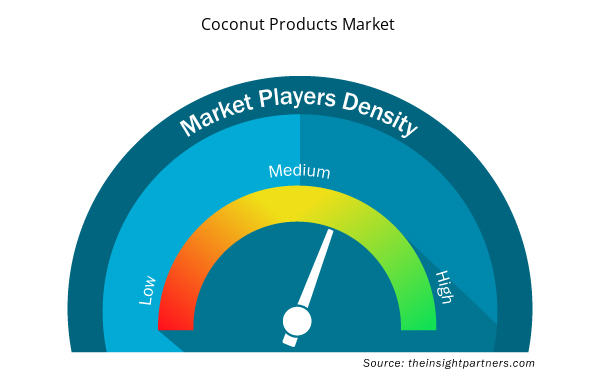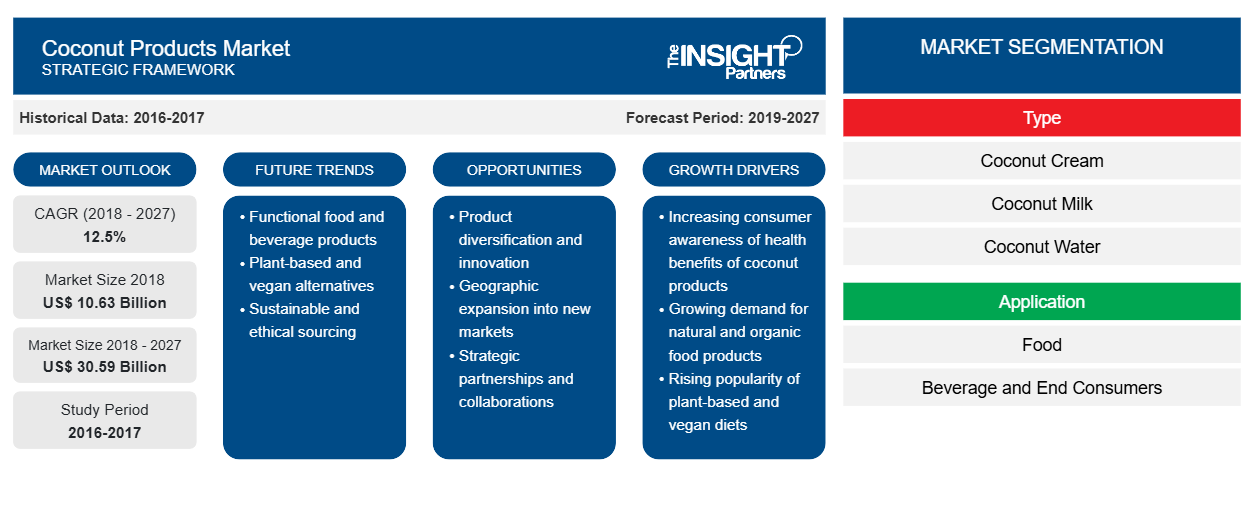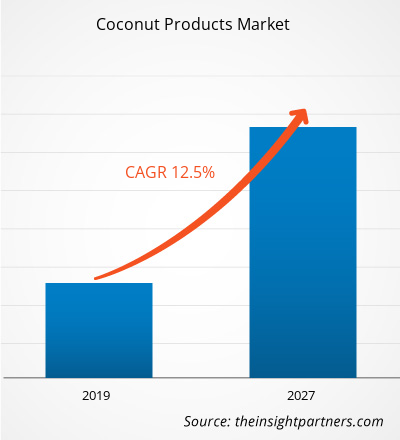[研究报告] 2018 年椰子产品市场价值为 106.2783 亿美元,预计到 2027 年将达到 305.8753 亿美元;预计 2019 年至 2027 年的复合年增长率为 12.5%。
椰子营养丰富,富含纤维、维生素 C、E、B1、B3、B5 和 B6,以及钠、铁、钙、镁、磷和硒等矿物质。椰子制品(即从椰子中提取或衍生的产品)可改善心血管健康、促进血糖控制、帮助减肥并增强阿尔茨海默病患者的大脑功能。椰子水可促进肾脏健康、具有保护心脏的作用、在运动后提供补水作用、有助于维持血压水平并有助于糖尿病管理。
预计北美椰子产品市场在预测期内将以最高的复合年增长率增长。该地区市场的增长主要归因于消费者对健康食品和椰子产品等配料的倾向性增加。美国、加拿大和墨西哥等国的消费者对饮食和食物摄入量更加关注。此外,对椰奶、椰奶和酒精饮料中的水等椰子产品的需求激增,进一步刺激了北美对椰子产品的需求。美国是该地区的主要市场,其次是加拿大和墨西哥。北美是投资椰子产品的诱人市场,因为这些产品在食品饮料和食品服务行业中得到广泛使用。
定制此报告以满足您的需求
您可以免费定制任何报告,包括本报告的部分内容、国家级分析、Excel 数据包,以及为初创企业和大学提供优惠和折扣
- 获取此报告的关键市场趋势。这个免费样品将包括数据分析,从市场趋势到估计和预测。
COVID-19 疫情对椰子产品市场的影响
由于封锁、旅行禁令和企业停业,COVID-19 疫情对各国的经济和行业产生了不利影响。由于全球疫情危机和各国无限期封锁,食品和饮料行业对家庭主食、健康食品和保质期较长的食品的需求很高。因此,对椰子粉、椰子油、椰奶和椰奶奶油等国产和保质期较长的椰子产品的需求也在增加。目前,市场上的主要椰子生产商面临着供应链挑战和产品消费量低的问题。主要参与者正专注于修改和改变他们的供应链,以加强他们的在线业务和交付措施,试图适应当前的
商业场景。消费者购买行为、饮食习惯的变化以及向在线分销渠道的重大转变可能会对预测期内椰子产品市场的增长产生严重影响。
市场洞察
食品配方和其他食品中椰子衍生物的使用量增加预计将推动椰子产品市场的增长
椰子和椰子衍生物已成为多种食品配方和产品的主要成分。椰子油、牛奶、面粉、水、奶油和糖;椰子碎或椰子丝;椰子干等产品广泛用于各种食品和饮料中。在亚洲国家,初榨椰子油被广泛用作食用油。椰子油是一种独特的食用油,因为它含有短链和中链饱和脂肪酸。由于其易熔性、令人愉悦的风味、良好的消化性和抗氧化酸败性,它在食品工业中得到广泛应用。它也可以用于人造黄油生产。椰子油是婴儿奶粉、代乳品、冰淇淋和糖果以及烘焙产品制备中的首选脂肪来源。脱水椰子主要用于糖果和其他食品工业。脱水椰子还用作各种家用食品制备中椰子碎的替代品。椰奶是一种速溶产品,可直接使用或用水稀释后用于制作咖喱、糖果、甜点、鱼和肉类菜肴、饼干、鸡尾酒、布丁、蛋糕、冰淇淋、椰子酱等。方便食品生产对椰子产品的需求也在增加。椰子饼干在即食零食产品类别中越来越受欢迎,它们主要由通用面粉和椰子粉组成,还有黄油、可可和生姜等其他成分来增强口感。椰子饼干在常温条件下的保质期为三个月。这些饼干美味可口,营养丰富,热量低,纤维含量高,在美国、亚太、欧洲、中东和非洲国家非常受欢迎。此外,椰子糖是另一种以椰子为基础的产品,由椰奶和椰丝混合而成。这是一种主要在亚太国家生产的新型零食产品。椰子巧克力由含有椰丝糖和牛奶黄油的椰子壳制成,表面涂有巧克力。该产品在冷藏条件下保质期为三个月,在欧洲、澳大利亚、北美、中东和中国有着广泛的需求。
类型洞察
根据类型,椰子产品市场分为椰奶、椰奶、椰水、椰糖、椰油、椰丝、椰干等2011 年,椰子油占据了较大的市场份额9. 椰子油是一种无色无味的产品,是从成熟椰子的果仁中提取的。根据提取方式,椰子油分为两种类型:未精制的椰子油和精制或初榨椰子油。根据美国国家生物技术信息中心 (NCBI) 发布的一份报告,椰子油对阿尔茨海默病患者有积极影响,因为它可以减少与该疾病相关的认知缺陷。此外,剑桥大学的一项研究表明,椰子油可以降低患心血管疾病的风险。椰子油可以提高高密度脂蛋白 (HDL),即好胆固醇的水平,从而降低患心脏病的风险。此外,椰子油中的脂肪酸有助于燃烧有害的身体脂肪,从而为大脑和身体功能提供能量。椰子油在印度和中国等亚洲国家用于烹饪。印度政府开展了宣传活动,强调椰子油的健康益处,以振兴国内椰子产业。此外,由于其抗衰老、抗氧化和抗菌特性,这种油还用于化妆品行业。
应用程序洞察
根据应用,椰子产品市场细分为食品、饮料和终端消费者。2019 年,食品部门占据了最大的市场份额。椰子产品用于咖喱、糖果、烘焙、零食等。对更健康的乳制品替代品的需求不断增加,预计将增加椰子产品在食品中的应用。椰子水、椰子油和椰奶在亚洲和泰国烹饪中被广泛使用。椰子产品的甜味和坚果味适合各种食品,从烤红薯到糖果棒。消费者日益增强的健康意识也增加了对椰子产品食品的需求。椰子产品富含矿物质、维生素、锰、钙、磷和许多其他营养素。椰奶含有高热量,其中 93% 的热量来自中链甘油三酯 (MCT)。MCT 有助于减肥和健康的新陈代谢,并增强身体机能。此外,椰子中含有大量的锰,这对骨骼健康和增强新陈代谢必不可少。食用初榨椰子油可减少腹部脂肪,而腹部脂肪是糖尿病和心脏病的主要原因之一。椰奶和酸奶正在取代许多制剂和美食中传统的牛奶用法。此外,民众乳糖不耐症患病率的大幅上升也增加了椰奶的使用量。
椰子产品市场中的一些参与者包括 Marico、百事可乐公司、可口可乐公司、椰子公司、Nexpo Conversion、达能公司、雀巢公司、Sambu Group、泰国农业食品有限公司和泰国椰子公共有限公司等。主要公司实施并购和研发战略,以扩大客户群并在全球市场中获得显著份额,这也使他们能够在全球范围内保持自己的品牌名称。
椰子产品市场区域洞察
Insight Partners 的分析师已详细解释了预测期内影响椰子产品市场的区域趋势和因素。本节还讨论了北美、欧洲、亚太地区、中东和非洲以及南美和中美洲的椰子产品市场细分和地理位置。

- 获取椰子产品市场的区域特定数据
椰子产品市场报告范围
| 报告属性 | 细节 |
|---|---|
| 2018 年市场规模 | 106.3亿美元 |
| 2027 年市场规模 | 305.9亿美元 |
| 全球复合年增长率(2018 - 2027) | 12.5% |
| 史料 | 2016-2017 |
| 预测期 | 2019-2027 |
| 涵盖的领域 | 按类型
|
| 覆盖地区和国家 | 北美
|
| 市场领导者和主要公司简介 |
|
市场参与者密度:了解其对商业动态的影响
椰子产品市场正在快速增长,这得益于终端用户需求的不断增长,而这些需求又源于消费者偏好的不断变化、技术进步以及对产品优势的认识不断提高等因素。随着需求的增加,企业正在扩大其产品范围,进行创新以满足消费者的需求,并利用新兴趋势,从而进一步推动市场增长。
市场参与者密度是指在特定市场或行业内运营的企业或公司的分布情况。它表明在给定市场空间中,相对于其规模或总市场价值,有多少竞争对手(市场参与者)存在。
在椰子产品市场运营的主要公司有:
- 马里科
- 百事可乐公司
- 可口可乐公司
- 椰子公司
- Nexpo 转换
免责声明:上面列出的公司没有按照任何特定顺序排列。

- 获取椰子产品市场顶级关键参与者概览
报告亮点
- 椰子产品市场的渐进式行业趋势可帮助参与者制定有效的长期战略
- 发达市场和发展中市场采用的业务增长战略
- 2019 年至 2027 年椰子产品市场定量分析
- 全球椰子产品需求量估计
- PEST 分析可说明行业内买家和供应商的效率
- 了解竞争市场状况的最新发展
- 市场趋势和前景以及推动和抑制椰子产品市场增长的因素
- 通过强调支撑商业利益的市场策略来协助决策过程,从而促进市场增长
- 不同节点椰子产品市场规模
- 市场的详细概述和细分,以及椰子产品行业动态
- 各地区椰子产品市场规模及增长潜力
椰子产品市场-按类型
- 椰奶
- 椰奶
- 椰子水
- 椰子糖
- 椰子油
- 椰子碎/碎丝
- 椰蓉
- 其他的
椰子产品市场 – 按应用分类
- 食物
- 饮料
- 最终消费者
椰子产品市场-按分销渠道
- 大卖场和超市
- 便利店
- 网上零售
- 其他的
公司简介
- 马里科
- 百事可乐公司
- 可口可乐公司
- 椰子公司
- Nexpo 转换
- 达能公司
- 雀巢公司
- 三务集团
- 泰国农业食品股份有限公司
- 泰国椰子股份有限公司
- 历史分析(2 年)、基准年、预测(7 年)及复合年增长率
- PEST 和 SWOT 分析
- 市场规模价值/数量 - 全球、区域、国家
- 行业和竞争格局
- Excel 数据集



Report Coverage
Revenue forecast, Company Analysis, Industry landscape, Growth factors, and Trends

Segment Covered
This text is related
to segments covered.

Regional Scope
North America, Europe, Asia Pacific, Middle East & Africa, South & Central America

Country Scope
This text is related
to country scope.
常见问题
The growth of the coconut oilsegment is primarily attributed to its unique characteristics such as saturated fat content, high stability, and biodegradability, and it provides long shelf life to fried products. Moreover, the oil is characterized by a high smoke point compared to other options. Also, as it is solid at room temperature, coconut oil can be used in baking recipes, for frying, and for greasing baking pans.
In 2018,the coconut products marketwas predominantinAsia Pacificat theglobal level.. This growth is primarily attributed to wide utilization of coconut products such as coconut cream, coconut milk, coconut water, coconut sugar, coconut oil, grated/shredded coconut, and desiccated in various regional cuisines and recipes. The growing production of coconut in Southeastern parts of Asia, along with the easy availability of coconuts as a raw material, further propels the market in Asia Pacific.
The major players operating in the globalcoconut products market are Marico, PepsiCo Inc., The Coca-Cola Company, The Coconut Company, Nexpo Conversion, Danone S.A., Nestle S.A., Sambu Group, THAI Agri Food Plc., and Thai Coconut Public Company Limited, among others.
Trends and growth analysis reports related to Food and Beverages : READ MORE..
The List of Companies - Coconut Products Market
- Marico
- PepsiCo, Inc.
- The Coca-Cola Company
- The Coconut Company
- Nexpo Conversion
- Danone S.A.
- Nestle S.A.
- Sambu Group
- THAI Agri Food Plc.
- Thaicoconut
The Insight Partners performs research in 4 major stages: Data Collection & Secondary Research, Primary Research, Data Analysis and Data Triangulation & Final Review.
- Data Collection and Secondary Research:
As a market research and consulting firm operating from a decade, we have published and advised several client across the globe. First step for any study will start with an assessment of currently available data and insights from existing reports. Further, historical and current market information is collected from Investor Presentations, Annual Reports, SEC Filings, etc., and other information related to company’s performance and market positioning are gathered from Paid Databases (Factiva, Hoovers, and Reuters) and various other publications available in public domain.
Several associations trade associates, technical forums, institutes, societies and organization are accessed to gain technical as well as market related insights through their publications such as research papers, blogs and press releases related to the studies are referred to get cues about the market. Further, white papers, journals, magazines, and other news articles published in last 3 years are scrutinized and analyzed to understand the current market trends.
- Primary Research:
The primarily interview analysis comprise of data obtained from industry participants interview and answers to survey questions gathered by in-house primary team.
For primary research, interviews are conducted with industry experts/CEOs/Marketing Managers/VPs/Subject Matter Experts from both demand and supply side to get a 360-degree view of the market. The primary team conducts several interviews based on the complexity of the markets to understand the various market trends and dynamics which makes research more credible and precise.
A typical research interview fulfils the following functions:
- Provides first-hand information on the market size, market trends, growth trends, competitive landscape, and outlook
- Validates and strengthens in-house secondary research findings
- Develops the analysis team’s expertise and market understanding
Primary research involves email interactions and telephone interviews for each market, category, segment, and sub-segment across geographies. The participants who typically take part in such a process include, but are not limited to:
- Industry participants: VPs, business development managers, market intelligence managers and national sales managers
- Outside experts: Valuation experts, research analysts and key opinion leaders specializing in the electronics and semiconductor industry.
Below is the breakup of our primary respondents by company, designation, and region:

Once we receive the confirmation from primary research sources or primary respondents, we finalize the base year market estimation and forecast the data as per the macroeconomic and microeconomic factors assessed during data collection.
- Data Analysis:
Once data is validated through both secondary as well as primary respondents, we finalize the market estimations by hypothesis formulation and factor analysis at regional and country level.
- Macro-Economic Factor Analysis:
We analyse macroeconomic indicators such the gross domestic product (GDP), increase in the demand for goods and services across industries, technological advancement, regional economic growth, governmental policies, the influence of COVID-19, PEST analysis, and other aspects. This analysis aids in setting benchmarks for various nations/regions and approximating market splits. Additionally, the general trend of the aforementioned components aid in determining the market's development possibilities.
- Country Level Data:
Various factors that are especially aligned to the country are taken into account to determine the market size for a certain area and country, including the presence of vendors, such as headquarters and offices, the country's GDP, demand patterns, and industry growth. To comprehend the market dynamics for the nation, a number of growth variables, inhibitors, application areas, and current market trends are researched. The aforementioned elements aid in determining the country's overall market's growth potential.
- Company Profile:
The “Table of Contents” is formulated by listing and analyzing more than 25 - 30 companies operating in the market ecosystem across geographies. However, we profile only 10 companies as a standard practice in our syndicate reports. These 10 companies comprise leading, emerging, and regional players. Nonetheless, our analysis is not restricted to the 10 listed companies, we also analyze other companies present in the market to develop a holistic view and understand the prevailing trends. The “Company Profiles” section in the report covers key facts, business description, products & services, financial information, SWOT analysis, and key developments. The financial information presented is extracted from the annual reports and official documents of the publicly listed companies. Upon collecting the information for the sections of respective companies, we verify them via various primary sources and then compile the data in respective company profiles. The company level information helps us in deriving the base number as well as in forecasting the market size.
- Developing Base Number:
Aggregation of sales statistics (2020-2022) and macro-economic factor, and other secondary and primary research insights are utilized to arrive at base number and related market shares for 2022. The data gaps are identified in this step and relevant market data is analyzed, collected from paid primary interviews or databases. On finalizing the base year market size, forecasts are developed on the basis of macro-economic, industry and market growth factors and company level analysis.
- Data Triangulation and Final Review:
The market findings and base year market size calculations are validated from supply as well as demand side. Demand side validations are based on macro-economic factor analysis and benchmarks for respective regions and countries. In case of supply side validations, revenues of major companies are estimated (in case not available) based on industry benchmark, approximate number of employees, product portfolio, and primary interviews revenues are gathered. Further revenue from target product/service segment is assessed to avoid overshooting of market statistics. In case of heavy deviations between supply and demand side values, all thes steps are repeated to achieve synchronization.
We follow an iterative model, wherein we share our research findings with Subject Matter Experts (SME’s) and Key Opinion Leaders (KOLs) until consensus view of the market is not formulated – this model negates any drastic deviation in the opinions of experts. Only validated and universally acceptable research findings are quoted in our reports.
We have important check points that we use to validate our research findings – which we call – data triangulation, where we validate the information, we generate from secondary sources with primary interviews and then we re-validate with our internal data bases and Subject matter experts. This comprehensive model enables us to deliver high quality, reliable data in shortest possible time.


 获取此报告的免费样本
获取此报告的免费样本